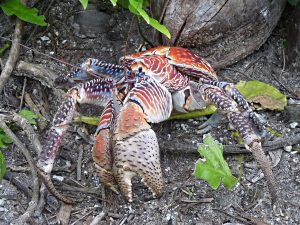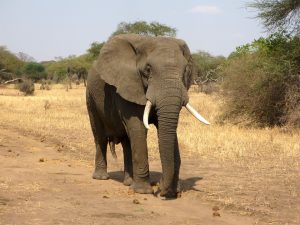General Characteristics of Phylum Chordata
- Although not the largest, Chordates are the most diverse phylum in the animal kingdom.
- Chordates have bilateral symmetry at some stage of the life cycle
- A degree of cephalization
- Have a closed circulatory system (the blood is closed at all times within vessels – it does not fill body cavities).
Some anatomical terms before we begin:
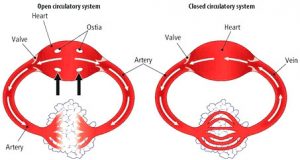
(https://grbodysystems.files.wordpress.com/2015/03/openclosedsystems.jpg?w=800&h=427)\we begin:
· Anterior – Towards the front of the animal
· Posterior – Towards the tail of the animal
· Ventral – Towards the belly of the animal
· Dorsal – Towards the back of the animal
Draw an example in your notes and label these 4 terms.
Chordates must have these four characteristics at some stage in their life cycle.
- Notochord
- The notochord is a rigid structure that lies just in front of the nerve chord.
- Support and protects the nerve chord.
- In vertebrates, the notochord is present in embryonic development and later develops into the vertebral column.
- Dorsal Nerve Cord
- In the vertebrates, the vertebrae (developed notochord) surround and protect the nerve cord creating the spine.
- Hollow structure containing the nerve chord.
- Pharyngeal (throat) Slits
-
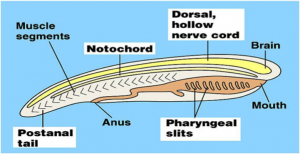
Figure 2: Amphixous with labelled Chordate characteristics Only visible during embroyonic stages.
- In water-breathing animals these become gills or gill slits.
- In air-breathing animals, these have many roles – not involved in respiration in human.
- Post Anal Tail
- Extension of nerve cord from behind anus.
Along with these traits, chordates also have an endoskeleton
- Varies greatly among chordates – from simple notochord (figure 2) to human skeleton.
Advantages of endoskeleton
- More flexible -> ability to grow is easier
- Grows with organism
- Less energy expenditure
- Can support greater weight without being impractically heavy.
Disadvantages of endoskeletons
- Doesn’t provide overall protection
| Exoskeleton | Endoskeleton |
| Provides overall protection (External)
|
Doesn’t provide overall protection, however most key organs are well protected in many (skull, spine, rib cage in humans as example) |
| Must be molted for organism to grow – makes organism vulnerable during molting times |
Does not have to be molted – grows with organism |
| Size restricted – if organism is too big the weight will be overwhelming
Ex: Largest terrestrial animal with exoskeleton: Coconut crab (Birgus latro)
|
Can support greater weight
Ex: Largest terrestrial animal with endoskeleton: African Bush Elephant (Loxodonta africana) |
| Higher energy expenditure | Lower energy expenditure |
| Made of chitin (arthropods), calcium carbonate | Made of bone and/or cartilage. |
We divide Phylum Chordata into three subphylums:
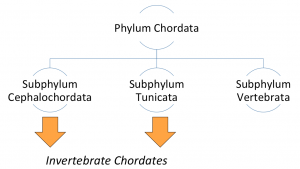
Subphylum Cephalochordata
- Invertebrate chordates (no vertebral column)
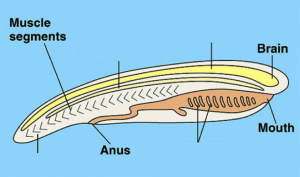
Figure 3: Unlabeled Amphixous - Maintain all four key characteristics throughout all life stages.
- The pharynx has ~100 pharyngeal slits which are used in feeding (filter food particles out of the water).
- Primitive or simple -> similar to chordate ancestors that gave rise to vertebrates.
- Ex. Lancets (Amphixous)
Label the four chordate characteristics on Amphixous in figure 3.
Subphylum Tunicata (Urochordata)
- Invertebrate chordates (no vertebral column)
- Have all four characteristics during larval stage but not adult form.
- Larval stage are free swimming
- Most adults tunicates are sessile (non-motile) and filter feeding (pharyngeal slits are modified for filter feeding).
- The larvaceans are a group of tunicates that remain in the larval form and do not become the sessile adult.
- Potential evolutionary link to free swimming fishes.
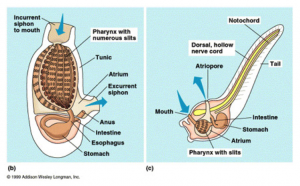
Figure 5: Tunicate larvae (b) and adult tunicate (c). Adult tunicates lose most of the chordate characteristics. 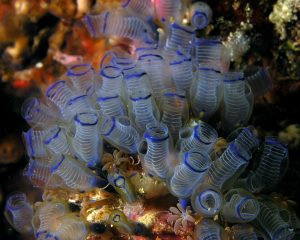
Figure 4: Adult Bluebell tunicates (Clavelina moluccensis)
Subphylum Vertebrata
Members of subphylum vertebrate are called vertebrates.
During development, the notochord is replaced with segmented series of bones called vertebrae. The dorsal nerve cord is modified into the spinal cord and brain in vertebrates. The vertebrae provide flexibility and protection to the spinal cord, which is protected by the neural arch.
Vertebrate characteristics:
- Vertebrae made of bone or cartilage that surround and protect the dorsal nerve cord. The vertebrae form a vertebral column or spine.
- A cranium or skull to protect the brain.
- An endoskeleton composed of bone or cartilage.
- Major evolutionary advancement – presence of a vertebral column, which protects the nerve cord
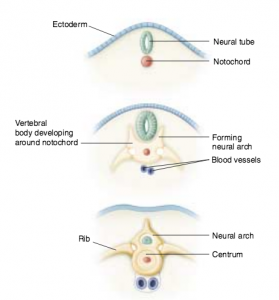
Figure 6: Development of vertebrae
We divided subphylum vertebrata into seven classes:
- Class Agnatha (Jawless fish)
- Class Chondrichthyes (Cartilaginous fish)
- Class Osteichthyes (Bony fish)
- Class Amphibia (Amphibians)
- Class Reptilia (Reptiles)
- Class Aves (Birds)
- Class Mammalia (Mammals)
- Vertebrates first appear in the fossil record 550 million years ago.
- Today there are ~ 60,000 species of vertebrates.
- About 55% of vertebrates are fish.
Extra Questions:
1. Identify the four defining traits of chordates.
2. Name and describe the two subphyla of invertebrate chordates.
3. Compare and contrast endoskeletons and exoskeletons.
4. What kind of circulatory system do chordates have? Describe it.
5. Describe the vertebral column. How is it related to the notochord and dorsal nerve cord?
6. What is meant by the term “invertebrate”?
7. Why is Amphixous considered a primitive chordate?
